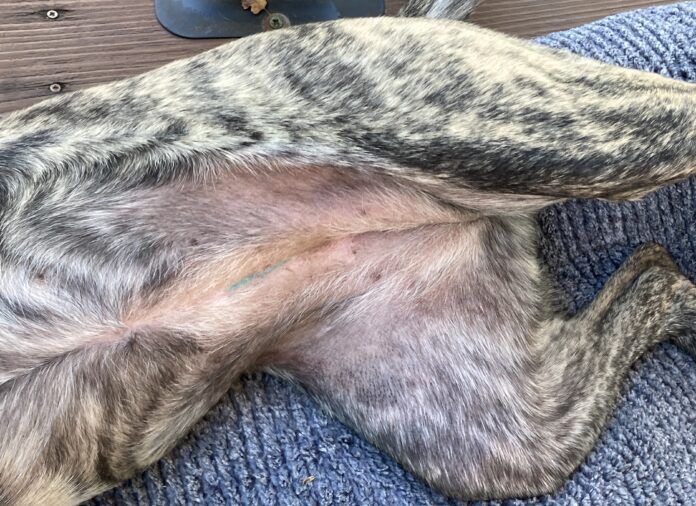Dogs who have been spayed or neutered may have a small tattoo on their abdomen, or “tummy.” Called a “sterilization indicator tattoo,” this short, straight line indicates that the dog has had his or her reproductive organs removed. Green is the most common tattoo color, and the most common placement is near or in the incision for male and female dogs. It’s mainly used in shelters and less so in private veterinary practices.
The tattoo idea was developed in 2010 to prevent unnecessary exploratory surgery when the spay/neuter status of a dog is unclear. In 2019, Dr. Meaghan Mielo, then an intern, surveyed shelters, spay/neuter clinics, veterinary colleges, and private veterinary practices about their awareness and use of sterilization tattoos in dogs and found that the tattoo was not routinely used. Her findings were published in the July 2022 edition of the peer-reviewed publication The Veterinary Journal. Dr. Mielo’s report recommended enhanced training for veterinarians to encourage the use of tattoos and protect animals from unnecessary procedures.
A Sterilization Tattoo on Dogs Is Important

While some spayed female dogs have a telltale surgical scar, it can be difficult to detect, forcing unnecessary exploratory surgery to determine her reproductive status. The tattoo, however, is easily seen, although hair may need to be shaved away on some dogs. However, some female dogs may still have their ovaries. Without a uterus, they are sterile, but the ovaries continue to secrete estrogen.
On a male, the lack of testicles would seem to be a clear indicator that the dog was neutered, it’s not that simple because:
- A male dog may have a retained testicle (or two). In these cases, the scrotum appears empty, as if he had been castrated, but the testicle(s) may still be there, undescended and remaining in the dog’s abdomen. These dogs are generally infertile but still manufacture testosterone and develop secondary sexual characteristics like other intact males.
- Dogs can also be sporting synthetic testicles (Neuticles), which make the dog appear to have testicles but doesn’t. These devices can be surgically implanted in place of a dog’s testicles during neuter surgery.
- Male dogs may have had a vasectomy, so sperm can no longer be ejaculated, which may be done if the owner wants the dog to retain his testicles but be unable to impregnate a female dog.
Although no longer used, in another alternative sterilization procedure, called Zeutering, the ability of the testes to produce sperm was destroyed while retaining its ability to manufacture testosterone. (The manufacturer of Zeuterin stopped selling it in 2016.)
How Is the Dog’s Spay or Neuter Tattoo Applied?
In some cases, the tattoo ink is applied to a small, shallow incision made in the dog’s skin close to the site of their surgical incision. After the ink application, the skin is gently stretched and a tiny amount of glue is applied to the tattoo to prevent the ink from spreading. A video at the ASPCA website demonstrates that style of tattoo application. Other clinics prefer to apply the tattoo ink directly to a short section of the dog’s spay or neuter incision itself.






